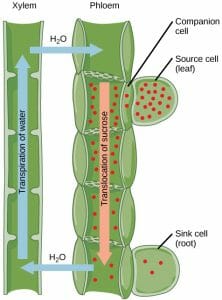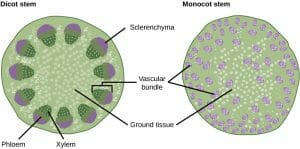Vascular Plant Definition
A vascular plant is any one of a number of plants with specialized vascular tissue. The two types of vascular tissue, xylem and phloem, are responsible for moving water, minerals, and the products of photosynthesis throughout the plant. As opposed to a non-vascular plant, a vascular plant can grow much larger. The vascular tissue within provides a means of transporting water to great heights, allowing a vascular plant to grow upward to catch the sun.
Structure of Vascular Plants
Inside of a vascular plant, the structure is much different from that of a non-vascular plant. In non-vascular plants, there is little to no differentiation between the different cells. In vascular plants, the specialized vascular tissues are arranged in unique patterns, depending on the division and species the vascular plant belongs to.
The xylem, made mostly of the structural protein lignin and dead cells, specializes in transporting water and minerals from the roots to the leaves. A vascular plant does this by creating a pressure on the water on multiple fronts. In the roots, water is absorbed into the tissues. The water flows into the xylem, and creates an upward pressure. At the leaves, water is being used and evaporates out of the stoma. These small pores are said to transpire, which pulls upward on the column of water in the xylem. Through the actions of adhesion and cohesion, the water moves upward through the xylem like a drink through a straw. This process can be seen below.
In the leaves, photosynthesis is taking place. A vascular plant, like the lower plants and algae, use the same process to extract energy from the sun, and store it in the bonds of glucose. This sugar is modified into other forms, and must be transported to parts of the plant with cannot photosynthesize, such as the stem and roots. The phloem is specially designed for this purpose. Unlike the xylem, the phloem is made of partially living cells, which help facilitate the transport of sugars via transport proteins found in the cell membranes. The phloem is also connected to the xylem, and can add water to help dilute and move the sugar. Commercially harvested, this is known as sap or syrup, such as Maple syrup.
Vascular Plant Lifecycle
Vascular plants exhibit, like all plants, an alternation of generations. This means that there are two forms of the plant, the sporophyte and the gametophyte. The sporophyte, a diploid organism, goes through meiosis to produce the haploid spore. The spore grows into a new organism, the gametophyte. The gametophyte is responsible for producing gametes, capable of fusing together during sexual reproduction.
These gametes, the sperm and egg, fuse together to form a zygote, which is the new diploid sporophyte generation. In some plants, this zygote will develop directly into a new organism. In others, the zygote develops into a seed, which is dispersed and must have a period of dormancy or some activation signal to begin growing. A vascular plant which is closer in relation to the mosses and non-vascular plants is more likely to have independent alternating generations. Seeding plants tend to have a highly reduced gametophyte, which is typically entirely dependent on and lives within the sporophyte. The distinction is hardly noticeable between the two organisms, besides the amount of DNA they carry within their cells (haploid vs. diploid) and the cellular division processes they use.
Classification of Vascular Plants
The vascular plants are embryophytes, which is a large clade or related group, consisting of both non-vascular and vascular plants. The embryophytes are further broken down into the Bryophytes including mosses, liverworts, and non-vascular plants, and Tracheophyta. As the trachea in humans is a passageway for air, the term tracheophyte refers to the vascular tissue in vascular plants.
The tracheophytes are further divided into divisions. The divisions are distinguished mostly on how their spores and gametophytes function. In ferns and club-mosses, the gametophyte becomes a free-living generation. In gymnosperms (conifers) and angiosperms (flowering plants), the gametophyte is dependent on the sporophyte. The gametes developed within become a seed, forming the next sporophyte generation. While every vascular plant shows an alternation of generations with a dominant sporophyte, they differ on how they go about distributing spores and seeds.
Examples of a Vascular Plant
Annual Vs. Perennial
Some plants, the annuals, complete their lifecycle within one year. If you were to buy an annual at the store, plant it in your garden, and collect all the seeds it dropped, the plant would not come back the next year. Annuals are typically herbaceous, meaning their stems and roots and not highly structured and rigid. While the plants may stand tall, this is mostly due to the effects of turgor pressure on the cell walls of the plant.
A perennial plant is slightly different. While it may also be herbaceous, the plant will return for multiple years, even if you collect all the seeds. The vascular plant, during the winter, is able to store sugar in the roots and avoid freezing entirely. In the spring, the plant can resume growing and try once more to produce offspring. While the methods of reproduction reflect millions of years of evolution, they do not reflect vascular plants compared to non-vascular.
Monocot Vs. Dicot
Within the angiosperms, or flowering plants, there is a huge division. While monocots and dicots are both vascular plants, they differ in the way that their seeds form, and the way that they grow. In a monocot, grow occurs below the soil, as individual leaves are started from near the roots and grow upward. Corn is a monocot, as well as many types of grasses including wheat and barley. In other seeding plants, like beans and peas, there are two cotyledon leaves making them dicots. The vascular tissue of the monocot can be seen on the right in the image below.
In a dicot, the growth point is above the soil, and this cause the plants to branch out in several directions. As such, the vascular tissue in a dicot is branched where in a monocot it runs parallel. Notice how the vascular tissue in these plants creates organized bundles. This pattern creates easy branching opportunities. These changes in vascular tissue represent the various methods of forming leaves to collect light seen in the two types of vascular plant.
Quiz
1. Which of the following is NOT a vascular plant?
A. Red Wood Tree
B. Moss
C. Peace Lilly
2. What is the purpose of the xylem in a vascular plant?
A. The xylem carries sugar around the plant
B. The xylem moves water from the roots to the shoots
C. The xylem transports the products of photosynthesis
3. Club-mosses are a unique organism. Like mosses, they do not create a seed and use spores to reproduce. Unlike mosses, they have distinguishable tissues which transport water throughout the plant. Club-mosses can grow considerably taller than normal moss. Which of the following is true?
A. Club-moss is a vascular plant
B. Club-moss is a non-vascular plant
C. Club-moss is neither vascular, nor non-vascular
References
- Hartwell, L. H., Hood, L., Goldberg, M. L., Reynolds, A. E., & Silver, L. M. (2011). Genetics: From Genes to Genomes. Boston: McGraw Hill.
- Kaiser, M. J., Attrill, M. J., Jennings, S., Thomas, D. N., Barnes, D. K., Brierley, A. S., & Hiddink, J. G. (2011). Marine Ecology: Processes, Systems, and Impacts. New York: Oxford University Press.
- McMahon, M. J., Kofranek, A. M., & Rubatzky, V. E. (2011). Plant Science: Growth, Development, and Utilization of Cultivated Plants (5th ed.). Boston: Prentince Hall.


